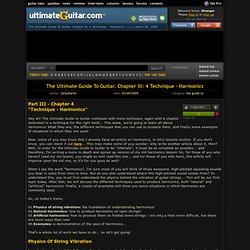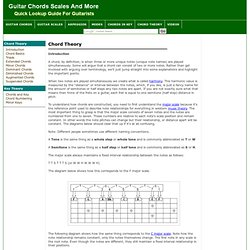

The Ultimate Guide To Guitar. Chapter III: 4 Technique - Harmonics. Part III - Chapter 4 "Technique - Harmonics" Hey all!

The Ultimate Guide to Guitar continues with more technique, again with a chapter dedicated to a technique for the right hand... This week, we're going to learn all about harmonics! What they are, the different techniques that you can use to produce them, and finally some examples of situations in which they are used! Physics Of String Vibration In order to understand the following 2 sections, in which I explain the techniques used to produce harmonics on the guitar, you must first understand how string vibration creates sound, and how altering this vibration can create harmonics... The uppermost waveform shows a vibration between both ends of the string... as you can see, the amplitude of the vibration is the greatest in the exact middle of the string (this means, the up and down motion of the string is the greatest in the middle). Natural Harmonics Like I said, "natural harmonics" are harmonics produced on open strings...
Examples. Chord Theory - Introduction. Introduction A chord, by definition, is when three or more unique notes (unique note names) are played simultaneously.

Some will argue that a chord can consist of two or more notes. Rather than get involved with arguing over terminology, we'll just jump straight into some explanations and highlight the important points. When two notes are played simultaneously we create what is called harmony. This harmonic value is measured by the "distance" or interval between the notes, which, if you like, is just a fancy name for the amount of semitones or half steps any two notes are apart. To understand how chords are constructed, you need to first understand the major scale because it's the reference point used to describe note relationships for everything in western music theory.
Note: Different people sometimes use different naming conventions. A Tone is the same thing as a whole step or whole tone and is commonly abbreviated as T or W T T S T T T S (or W W H W W W H) How to play an F major Chord on Guitar. Dansm's Guitar Chord Theory. The VII Zone. Because the Zone patterns in Fretography are named for their Diatonic position, you always know where you are within any key.

In the key of C major, the 7th scale degree is B. By a happy coincidence, B is found on the 7th fret of the 1st and 6th strings, so the VII Zone in the key of C is based on the 7th fret. If you position your 1st finger at the 7th fret the next three fingers align with the next three frets and stay that way when you play this pattern. Playing the pattern from low to high gives you the following fingering; string > finger 1st > 1 - 2 - 4 2nd > * - 2 - 4 3rd > 1 - 3 - 4 4th > 1 - 3 - 4.
Peter Vogl. InSync. CAGED. Fretboard. Notes. Programs. METRONOME ONLINE - free! Riffs. Scales. Chords.